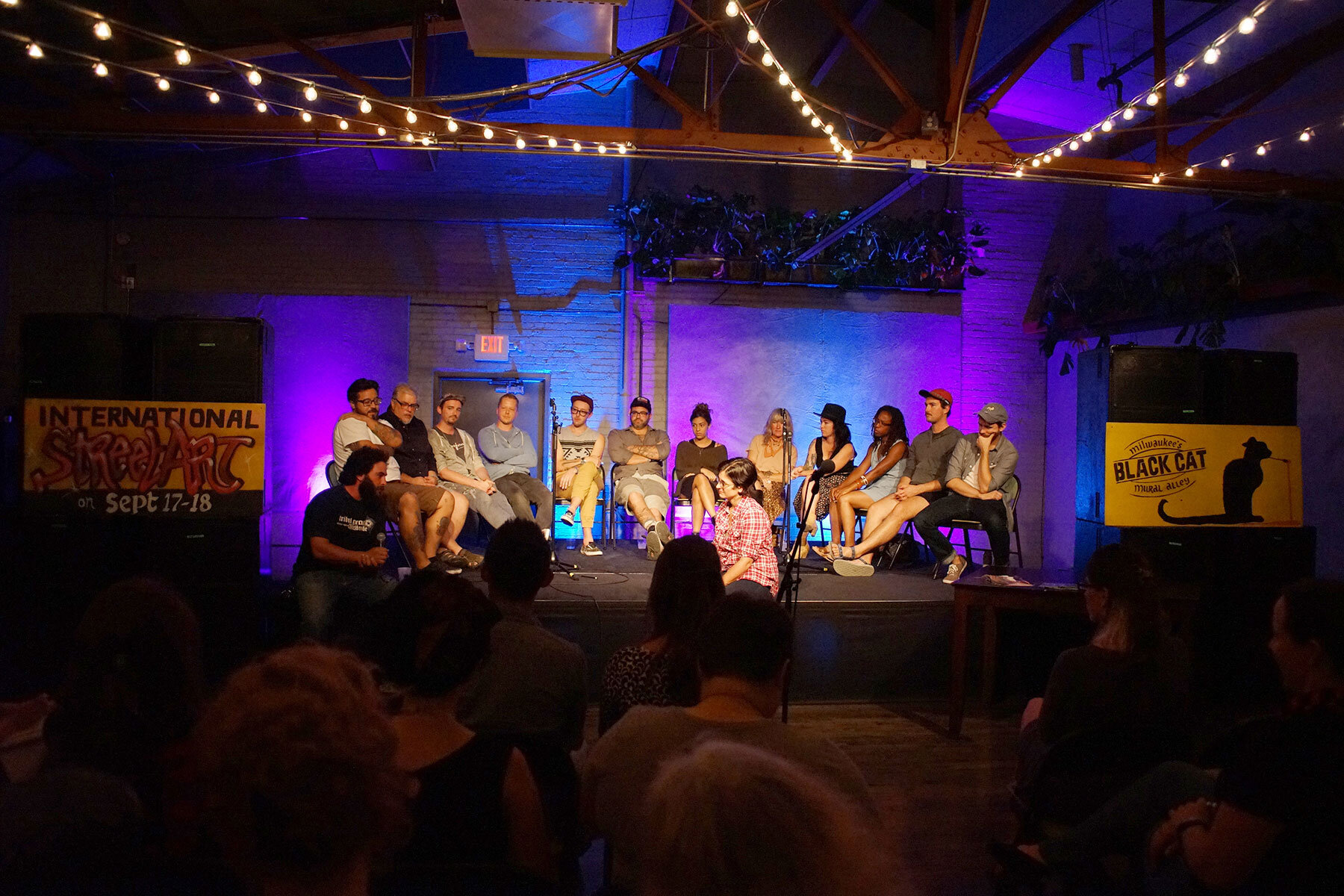BLACK CAT ALLEY PART 1: TRANSFORMATIVE ART
You can read the full article from the Milwaukee Independent here
The Black Cat Alley Mural Project officially opened to the public on the final day of Doors Open, featuring murals covering diverse issues in a variety of mediums. The project hopes to engage the East Side community in discussions about social justice issues and to inspire young artists.
Every day it seems a new mural appears around local neighborhoods as part of a street art movement that is gaining momentum in Milwaukee. Black Cat Alley, located between Kenilworth Place and Ivanhoe Place on the East Side, held its Grand Opening event on September 18. The site is now home to the biggest outdoor mural collection in the area.
Eleven international, national, and local artists each installed a mural each along the alley’s walls over a two week period that began September 5. The works of art cover a variety of topics, including the mass incarceration of African American men in Wisconsin, the value of stories, and ethnic folklore.
All eleven artists gathered in the performance room of the Colectivo on Prospect for a “Meet the Artist” panel on September 16, where they discussed the importance of street art, the inspiration behind their murals, and the project’s danger of inviting gentrification.
Stacey Williams-Ng, project leader of the Black Cat Mural Alley Project, opened the panel by describing her view, as an artist herself, regarding the mission of street art.
“We believe that street art is transformative,” said Williams-Ng. “We believe that it changes communities. All of us on this project, we believe that this is not just decorating brick. This is adding a voice to the neighborhood and doing something really special.”
All murals were installed in Black Cat Alley from September 5 to September 17, with the exception of the project launch in August by world-renowned French artist MTO. Though the artwork only took only took two weeks to install, the mural project took over two years to organize and implement.
The idea for the project came from Tim Decker, lecturer at Peck School of the Arts, UW-Milwaukee. He knew about the alley, which had previously been referred to as “Rape Alley,” or “The Oriental Drug Store,” and thought that perhaps art could bring life to it.
Under the guidance, planning, and persistence of Williams-Ng, the project came into being with the support of the East Side Business Improvement District (BID), who owns the alley, UW-Milwaukee, Colectivo, Blick Art Materials, and many other local organizations and businesses. After receiving permission from the owners of the alley, Williams-Ng formed a five-person jury to select the mural artists.
Artists were chosen based on samples of their art and a proposal of a mural they would install. In order to bring in a diversity of voices, the jury picked national artists, local artists ,and student artists. The talent from those submissions surpassed the jury’s expectations.
“We wanted to see every single mural challenge people in a different way,” said Williams-Ng. “Every single work of art says something else from the one beside it. It’s a complete mishmash and we love it. It’s a quilt of different voices.”
The mural provides artists with extraordinary amounts of freedom of expression. The large spaces offered the opportunity to use different mediums, so stories became larger than life and art becomes intensely interactive.
“It’s not put in a category and it’s not put in a box,” said Bunnie Reiss, a nationally recognized artist from Los Angeles who painted a mural in Black Cat Alley. “People don’t have to go into a building to see it. You can touch it, you can react to it, you can take a picture with it. You can really do whatever. It’s quite freeing in a country where you often you don’t feel free. You can really go crazy on a wall.”
The interactive component of the mural project was important to both the artists and the management team. The project was designed to engage the surrounding community and also inspire younger generations, especially those from minority communities, to pursue art.
“Art inspires people and art makes change,” said Decker. “This alley is one alley. There are other alleys in the city we can do. I’d like the artists to get out into the communities, to inspire some of those young kids who want to be artists, kids who get turned down and told ‘you won’t make it as an artist kid, hang it up.’ I want to inspire young people of all different cultures to get into art. This is one way this project can have tentacles, by inspiring others.”
At the panel, the artists also discussed ways the project could further serve its surrounding community. They would like to bring in sculpture artists, or perhaps build livable structures for homeless people. It was also suggested to host social programs in the alley on the weekends that had opportunities for drug and alcohol treatment.
The alley space will soon welcome a garden, and will always be open to the public, serving as a community art gallery that is accessible to all.
Work from the artists will be on display in an exhibition at the Villa Terrace Decorative Arts Museum through October 23.


